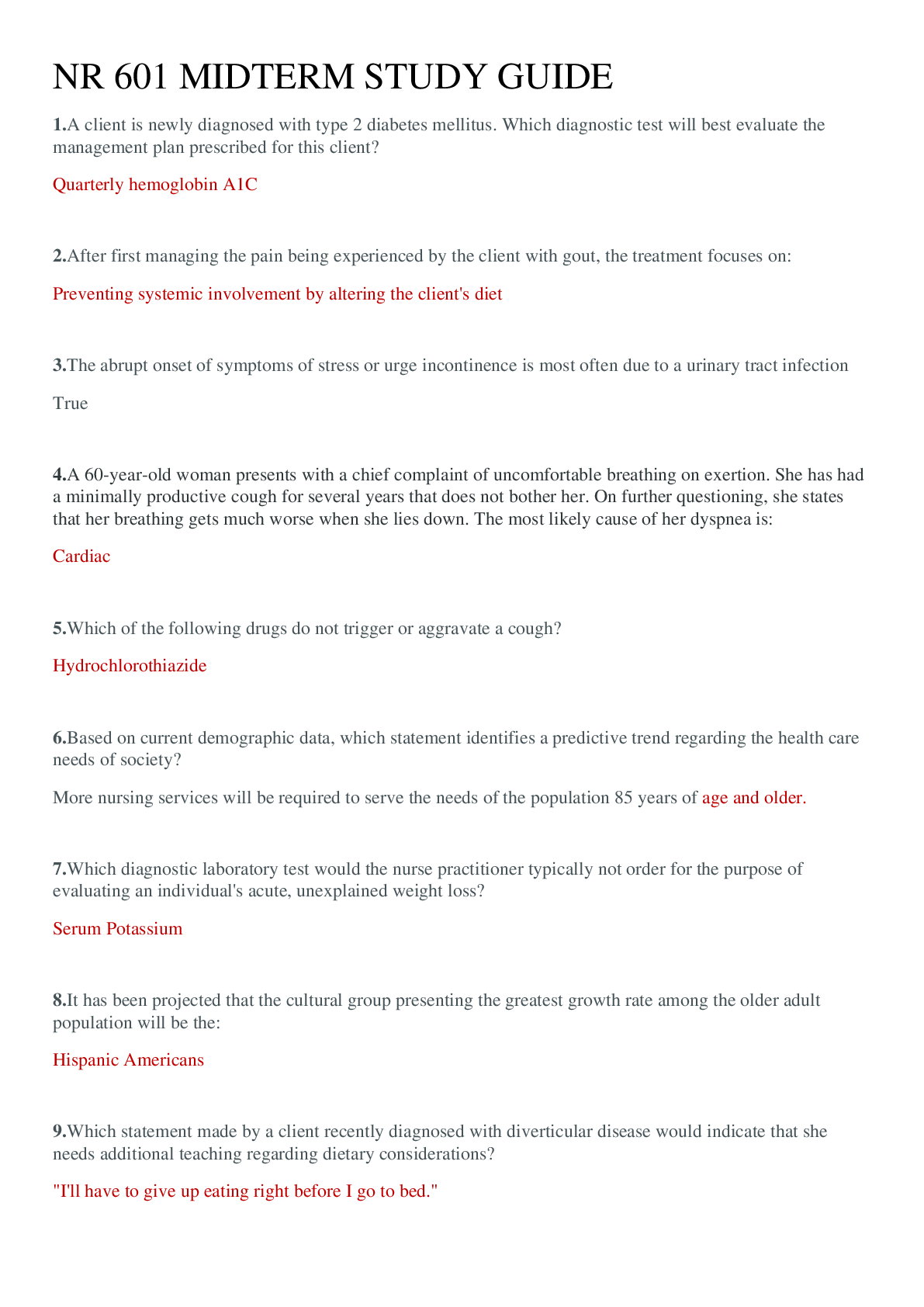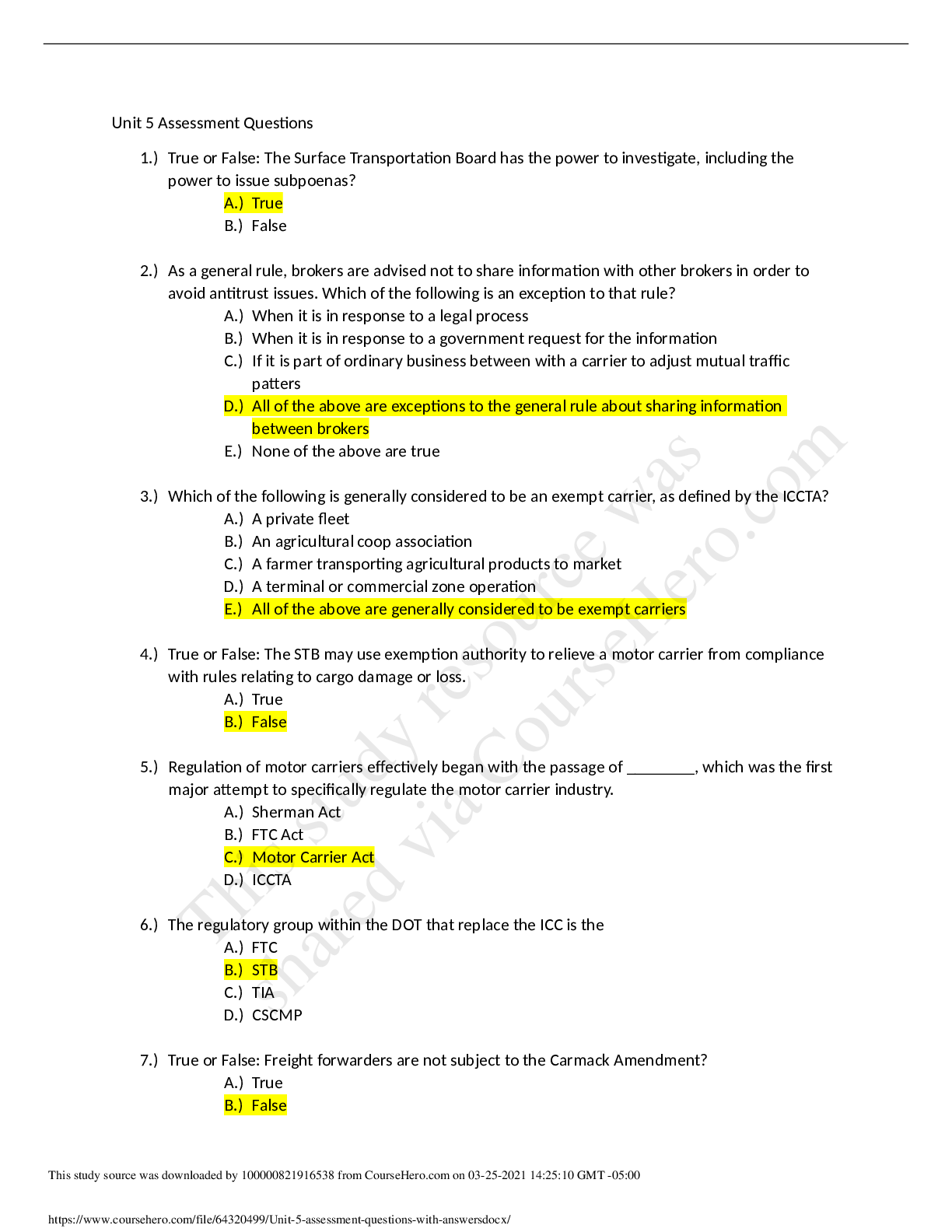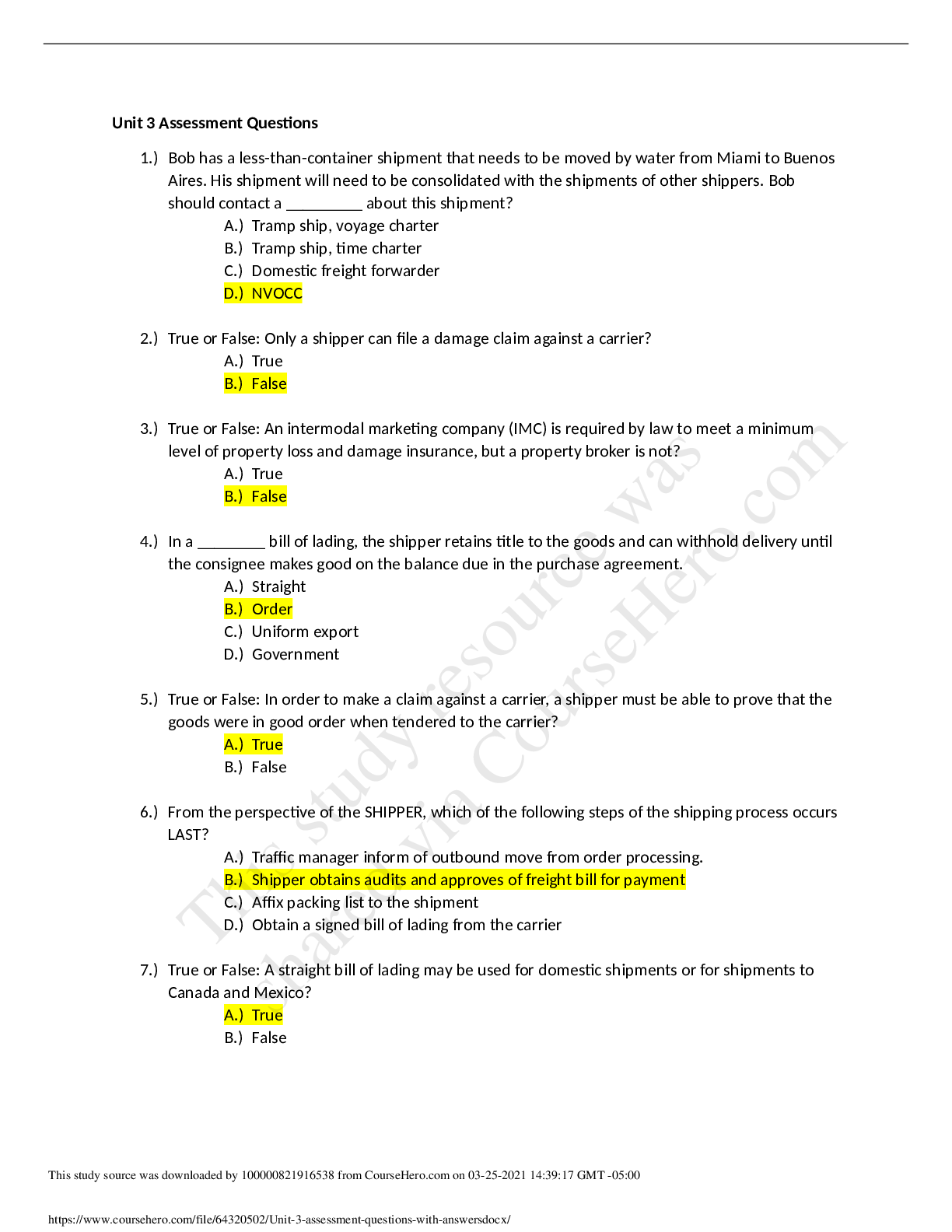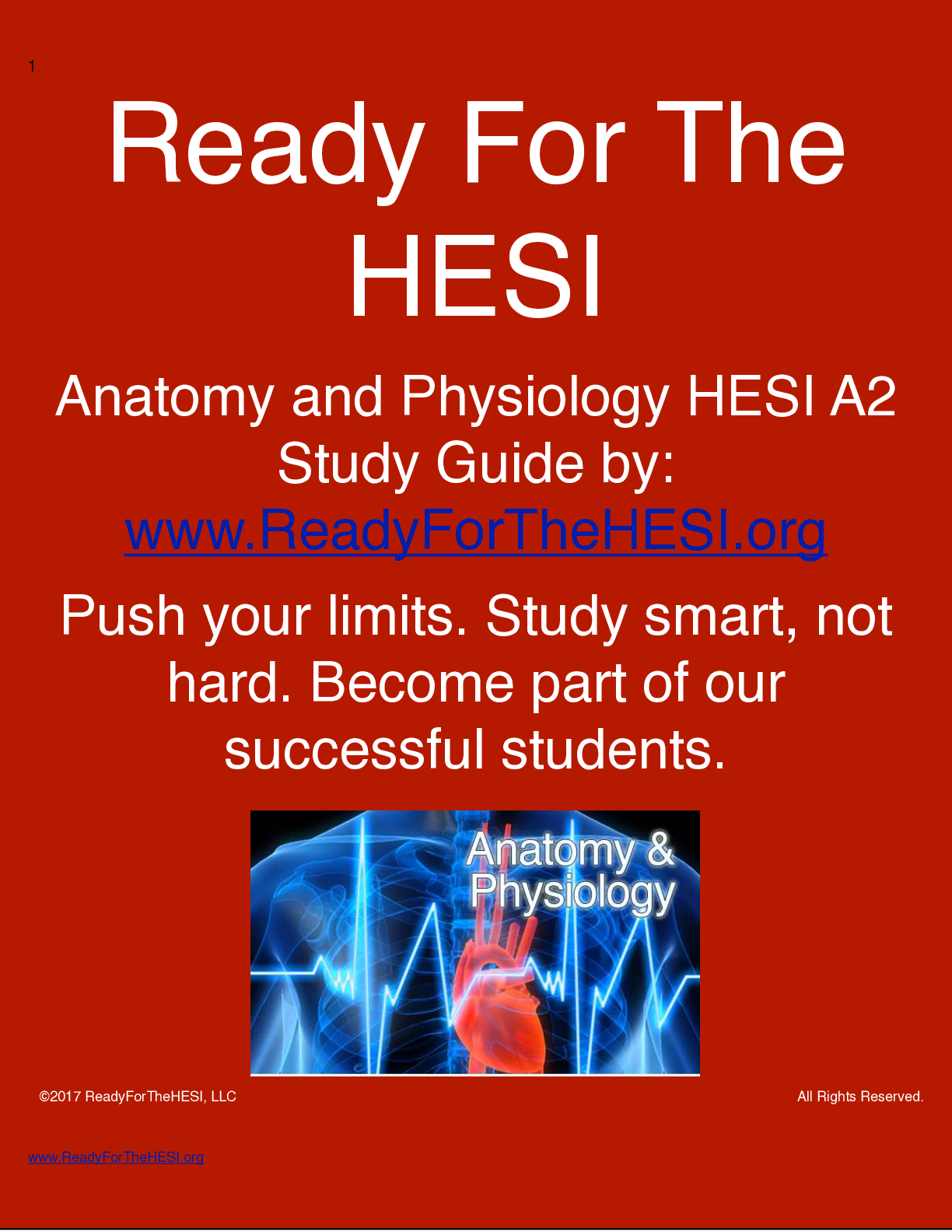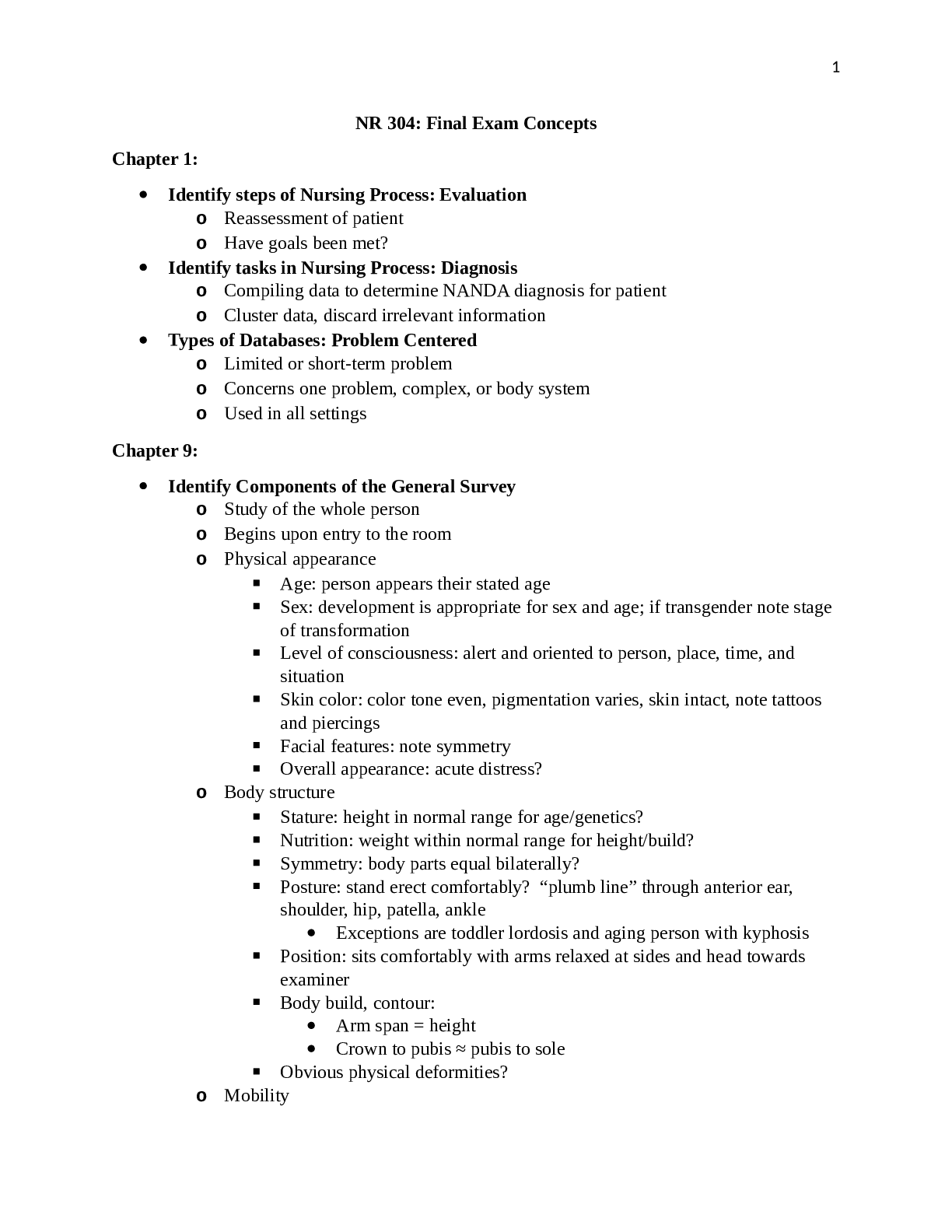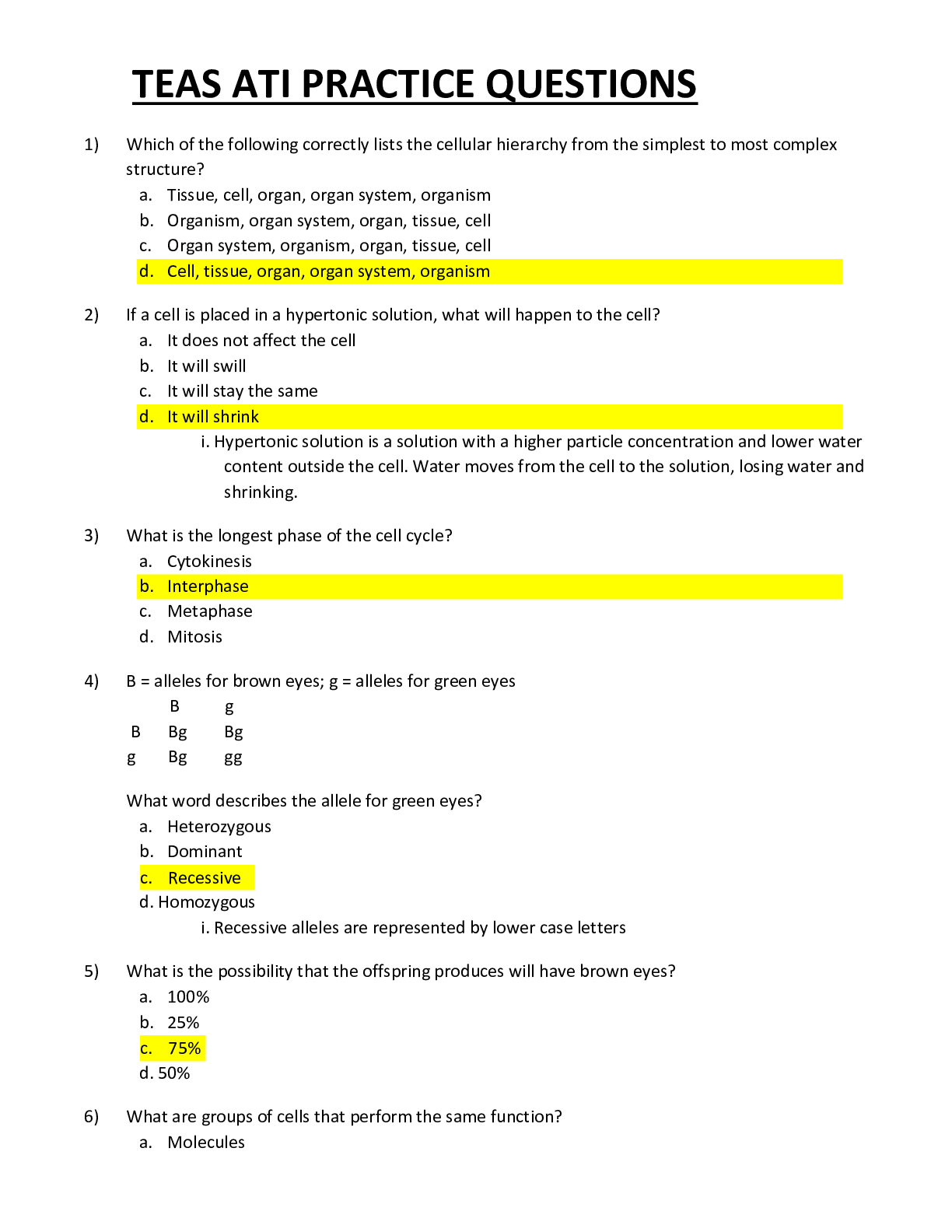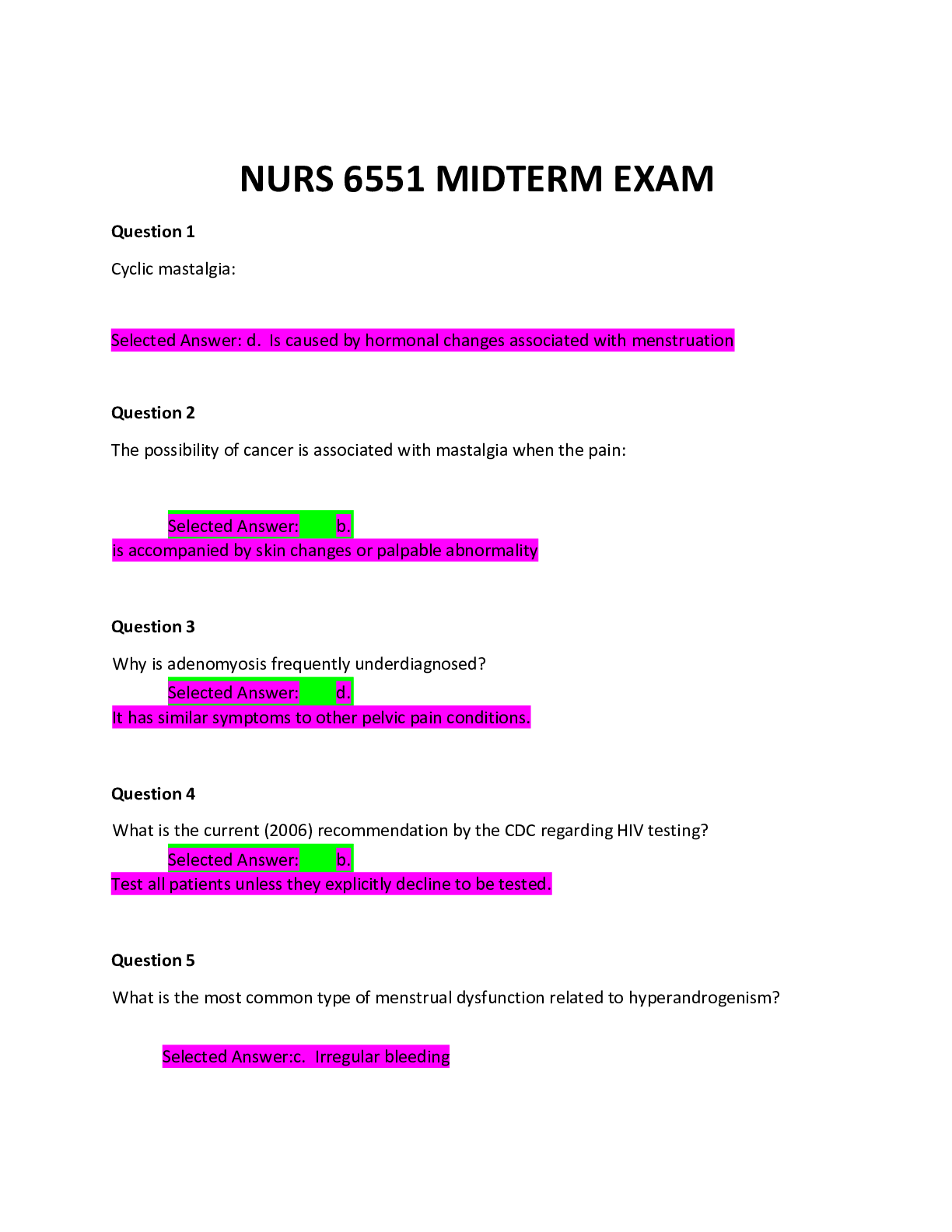Health Care > QUESTIONS & ANSWERS > NFPT Test Questions with Answers. 100% proven pass rate. Graded A+ (All)
NFPT Test Questions with Answers. 100% proven pass rate. Graded A+
Document Content and Description Below
If you want to build new mitochondria (to improve the endurance capability of the working muscles by increasing energy storage capacity) while also purposely expending as much stored glycogen as possi... ble (in order to maximize fat mobilization during recovery), you should stay in which rep range? - ✔✔20-25 Water content of muscle is about {74%} of its weight. - ✔✔74-76% List and briefly describe the six (6) components of wellness, using the acronym mnemonic, "SPICES" - ✔✔1) social health: how having genuine interactions with people face to face is crucial to our social health and overall wellbeing; 2) Physical health: has 5 components dealing with endurace, muscular endurance, muscular strength, flexibility, and body composition.; 3) Intellectual Health: how we integrate new information; 4) Cognitive Health: How we process information in our brains; 5) Emotional Health: How we view ourselves and our relationships; 6) Spiritual Health: Having a connection with a higher power.; Abduction - ✔✔Movement away from the body or body part's midline; lifting your arm up to the horizontal position at your side Adduction - ✔✔Movement toward the body or body part's midline; lowering your arm from the horizontal position back down to your side Extension - ✔✔The straightening of a joint that increases the angle; reaching out your arm, straightening at elbow Flexion - ✔✔The bending of a joint that decreases the angle; bending at elbow Internal Rotation - ✔✔Movement of body part towards the axis/towards center of body External Rotation - ✔✔Movement of body part away from axis/away from center of body Retraction - ✔✔Backward (posterior) movement of a body part; generally referring to scapulae and skull/cervical spine Protraction - ✔✔Forward (anterior) movement of a body part; generally referring to scapulae and skull/cervical spine Hyperextension - ✔✔Extension beyond normal limits, over extended; a body part or joint is bent backwards too far Hypoextension - ✔✔Extension that is less than normal, under-extended; not being able to extend at the knee because of a tight hamstring Gliding - ✔✔Movement of non-angular joints over each other Deviation - ✔✔Departure from the midline Pronation - ✔✔Palm of hand turning downward into a posterior position when arm is down at side; the inward roll of the foot/arch decreased during normal walking motion Supination - ✔✔Palm of hand turning upward into an anterior position when arm is down at side; the outward roll of the foot/arch heightened during normal walking motion Inversion - ✔✔Turning both feet inward so the soles face each other Eversion - ✔✔Turning both feet outward so the soles face away from each other Plantarflexion - ✔✔Pointing foot downward (e.g. going up on tiptoes) Dorsiflexion - ✔✔Pointing foot up towards the shin The ankle is distal to the hip. - ✔✔True The wrist is distal to the shoulder. The ______ is proximal to the wrist. - ✔✔elbow The knee is _____ to the hip and _____ to the ankle. - ✔✔distal; proximal List the 4 types of contraction: - ✔✔1) isometric 2) isokinetic 3) isotonic - eccentric 4) isotonic - concentric Isotonic - ✔✔Where the load on the muscle is less than the generated tension, resulting in movement Isokinetic - ✔✔Where the muscle contracts and shortens at a constant rate of speed Isometric - ✔✔Where the load on the muscle is greater than the generated tension, no movement takes place Eccentric - ✔✔Referred to by the increase in the length of the muscle during isotonic contraction; the "negative" part of the contraction Concentric - ✔✔Referred to by the decrease in the length of the muscle during isotonic contraction; the "positive" part of the contraction Sagittal Plane - ✔✔1) Vertical Plane 2) Divides: right and left sides Frontal Plane - ✔✔1) Motion = abduction and adduction 2) Divides: front half and back half Transverse Plane - ✔✔1) Horizontal Plane 2) Motion = internal rotation and external rotation The axial skeleton is made up of the bones in the: - ✔✔trunk, or center of the body The appendicular skeleton is made of the bones in the: - ✔✔limbs and upper and lower extremities Irregular Bones - ✔✔vertebrae, sacrum, coccyx, mandible, hyoid Flat Bones - ✔✔cranium, scapula, sternum, ribs, ilium (pelvis) Short Bones - ✔✔tarsals (in feet), carpals (in hands) Sesamoid Bones - ✔✔joint bones in hands, knee (patella), and feet Long Bones - ✔✔clavicle, humerus, radius, ulna, femur, tibia, fibula, metacarpals, metatarsals, phalanges 3 main classifications of joints - ✔✔1) Ligamentous 2) Cartilaginous 3) Synovial Ligamentous - ✔✔Immovable Cartilaginous - ✔✔Slightly moveable Synovial - ✔✔Highly moveable 6 types of synovial joints: - ✔✔1) Ball and Socket 2) Hinge 3) Pivot 4) Gliding 5) Saddle 6) Condyloid The shoulder joint is an example of a ________ type of joint. - ✔✔ball and socket joint The knee joint is an example of a ___________ type of joint. - ✔✔pivot joint A tendon: - ✔✔connects muscle to bone Ligaments are _________ elastic than tendons and are ________ prone to tearing than tendons. - ✔✔Less More Commonly called the 'Prime Movers', these are the muscles that contract to create the ROM through the joint, they are the muscles primarily responsible for the movement. - ✔✔Agonists These muscles, sometimes referred to as 'neutralizers', provide for assistance of the prime mover/s/ by neutralizing the force of the movement through the plane of motion. - ✔✔Synergists The triceps are the _____ to ______. - ✔✔antagonist ; biceps The quadratus lumborum stabilizes the spine in ___________. - ✔✔all planes The internal and external obliques _____ the trunk. - ✔✔rotate Which exercises are best for the quads? - ✔✔Lunges, squats and leg press Which exercises are best for hamstrings? - ✔✔Stiff leg deadlift, leg curl and reverse lunges What is the main function of the rectus abdominis? - ✔✔Flexion The hamstring muscles are: - ✔✔biceps femoris, semimembranosus and semitendonosus The gluteus maximus___ the hip. - ✔✔extends What four muscles make up the quadraceps? - ✔✔Rectus femoris, vastus lateralis, vastus medialis and vastus intermedius The ____ crosses the hip joint and the knee. - ✔✔rectus femoris The latissimus dorsi performs ____ motions through the arms. - ✔✔pulling ANTERIOR VIEW: Fill in the blanks with the name of each muscle, 1-13 - ✔✔1 {Deltoids} 2 {Pectorals} 3 {Biceps, Brachialis} 4 {Forearm, Brachioradialis} 5 {Flexors, Flexor Carpi Radialis, Palmaris Longus, Flexor Carpi Ulnaris} 6 {Quadriceps, Rectus Femoris} 7 {Vastus Lateralis} 8 {Vastus Medialis} 9 {Adductors, Pectineus, Adductor Longus, Adductor Magnus} 10 {Sartorius} 11 {Obliques} 12 {Abdominals, Rectus Abdominis} 13 {Sternocleidomastoid} POSTERIOR VIEW: Fill in the blanks with the name of each muscle, 14-26 - ✔✔14 {Upper back, Trapezius, Traps} 15 {Infraspinatus} 16 {Teres Major} 17 {Latissimus Dorsi, Lats} 18 {Lower back, Erector Spinae, Thoracolumbar Fascia} 19 {Iliac Crest} 20 {Glutes, Gluteus Maximus} 21 {Hamstrings, Biceps Femoris} 22 {Soleus} 23 {Calves, Gastrocnemius} 24 {Forearm, Extensors, Extensor Carpi Ulnaris, Extensor Digiti Minimi} 25 {Upper Arm, Triceps} [Show More]
Last updated: 2 years ago
Preview 1 out of 68 pages

Buy this document to get the full access instantly
Instant Download Access after purchase
Buy NowInstant download
We Accept:

Also available in bundle (1)
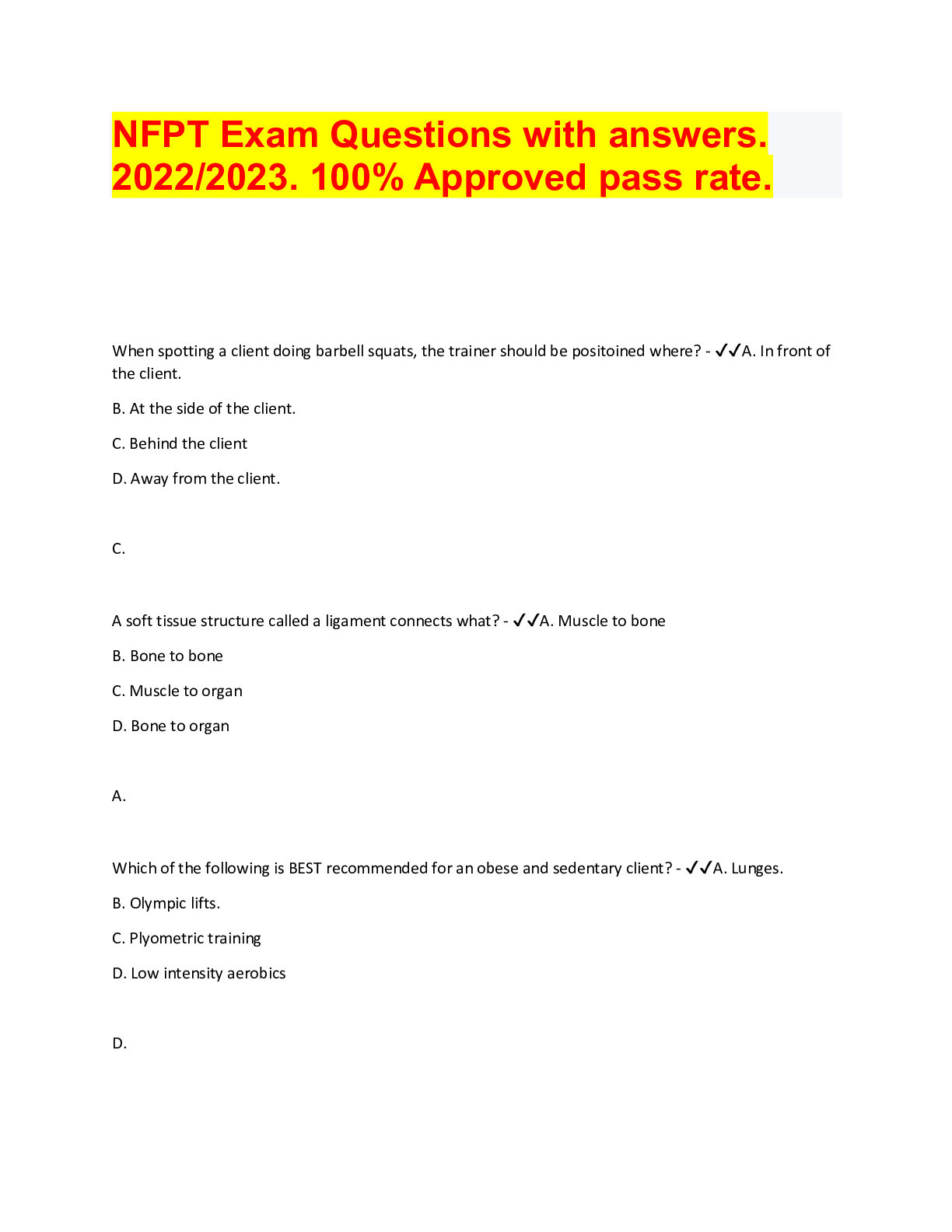
NFPT bundle, Questions with accurate answers.
3 versions of examinable masterpieces, rated A+
By bundleHub Solution guider 2 years ago
$16
3
Reviews( 0 )
$8.00
Can't find what you want? Try our AI powered Search
Document information
Connected school, study & course
About the document
Uploaded On
Aug 15, 2022
Number of pages
68
Written in
Seller

Reviews Received
Additional information
This document has been written for:
Uploaded
Aug 15, 2022
Downloads
0
Views
141













lee.png)

